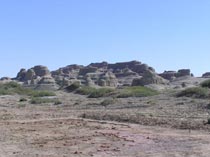| |
Ghost Castles
( 2005-09-13 )
 Qitai Ghost Castle Qitai Ghost Castle
 Qitai Ghost Castle is also called the "city of demons," lying in the depths of the Jiangjun Desert north in Qitai County of Northwest China's Xinjiang Uygur Autonomous Region. A mysterious masterpiece of a natural phenomenon, the "city," about 84 square kilometers in area, looks magnificent and majestic. For the past thousand years, it has been a spot of striking wonder in the desert. Qitai Ghost Castle is also called the "city of demons," lying in the depths of the Jiangjun Desert north in Qitai County of Northwest China's Xinjiang Uygur Autonomous Region. A mysterious masterpiece of a natural phenomenon, the "city," about 84 square kilometers in area, looks magnificent and majestic. For the past thousand years, it has been a spot of striking wonder in the desert.
The area is a part of the Yadan landscape. Throughout the long period of wind erosion, it has formed many various conformations like pavilions, castles, palaces, towers, and some eerily lifelike things, such as tigers, lions, camels, fungus, and so on; there are also fanciful scenery of wispy lakes, forests, cars, and so on.
As soon as night arrives, the big wind begins to blow -- sad, horrible, and shrill howls of wind reverberating about the ancient castle, filled with yellow sand, just like those of so many fierce devils. That's why it is known as the "city of demons."
 Wuerhe Ghost Castle Wuerhe Ghost Castle
 The Wuerhe Ghost Castle, also known as the "Wuerhe Wind City," is located in the Wuerhe area, over 100 kilometers northeast of Karamay City, and against the Halahlat Mountain. Its unique aeolian (wind-carved) landforms (one of the Yadan landforms) are rare in China. The Wuerhe Ghost Castle, also known as the "Wuerhe Wind City," is located in the Wuerhe area, over 100 kilometers northeast of Karamay City, and against the Halahlat Mountain. Its unique aeolian (wind-carved) landforms (one of the Yadan landforms) are rare in China.
The Wuhe Ghost Castle covers an area of about 30 square kilometers. After years of wind erosion, hills here were made into various figures, like the Liuhe Pagoda by the side of Qiantangjiang River in Hangzhou (East China's Zhejiang Province), the Heavenly Temple in Beijing, the pyramids of Egypt, the Angkor Wat Temple of Cambodia, and eagles spreading their wings, and so on.
|
|

